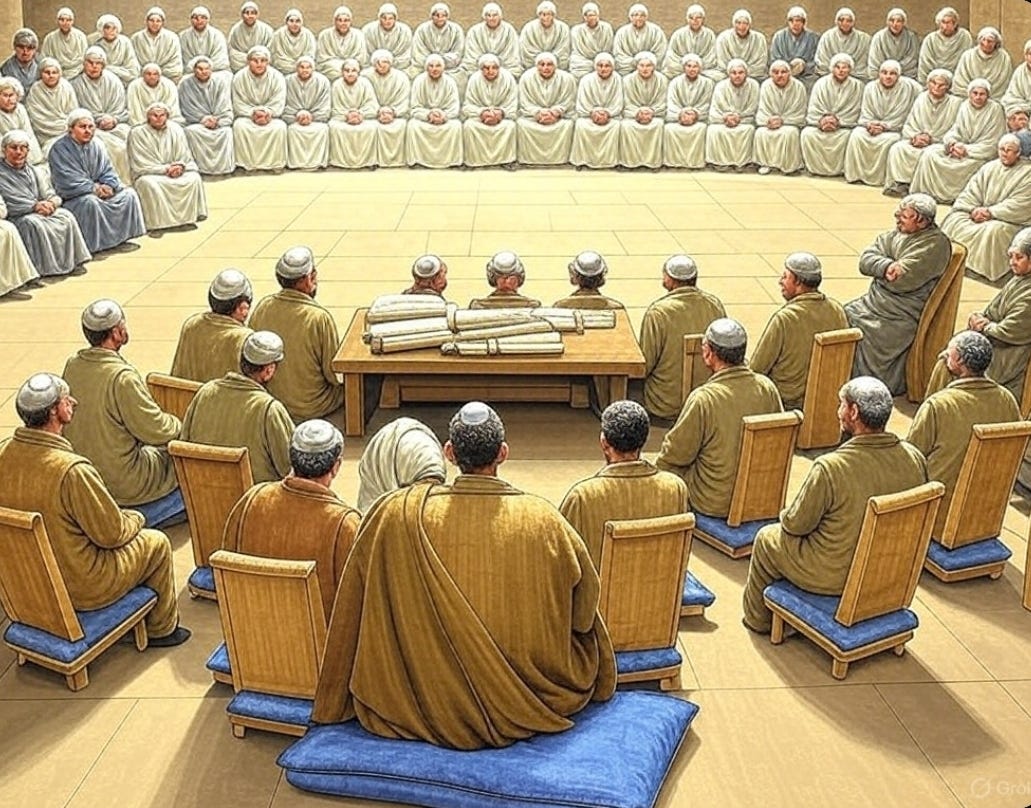On March 13, 2025, the nascent Sanhedrin—a modern effort to revive the ancient Jewish high court (may it be formed in our days)—issued a provocative ruling: “The people of Gaza led by the Hamas movement, and all those who support and help them, have upon them the Torah law of Amalek,” calling for Israel to “conquer and return sovereignty to Gaza and destroy Hamas, as was done in Shushan, in the days of Mordechai and Esther” (Israel365 News). This bold declaration, timed with Parashat Zachor before Purim, taps into deep biblical resonance, evoking the memory of Amalek’s unprovoked cruelty (Deuteronomy 25:17-18). Yet, it raises a critical question: can this body, lacking the Temple and classical semicha, wield the authority to make such a weighty call? The answer lies in a halachic process that demands restoration.
The Sanhedrin: A Legacy Interrupted
The Sanhedrin once stood as the pinnacle of Jewish governance, a court of 71 sages wielding supreme authority over Torah interpretation, judicial rulings, and even declarations of war. Its power rested on three pillars: semicha (ordination tracing back to Moses), its seat in the Lishkat HaGazit within the Temple, and the unified consent of the Jewish nation. Since the 4th-5th century CE, when Roman persecution severed the semicha chain and the Temple fell, this institution has lain dormant. The nascent Sanhedrin, formed in 2004, seeks to fill this void. But without those pillars, its rulings—however stirring—lack the binding force of halacha.
Restoring Authority: The Halachic Blueprint
Reviving the Sanhedrin begins with semicha. Maimonides (Mishneh Torah, Hilchot Sanhedrin 4:11) provides a roadmap: if the sages of Israel unanimously appoint a leader and ordain him, he could then ordain others, restarting the chain. This demands a consensus of globally recognized scholars—a bar the nascent Sanhedrin has not yet cleared. Many rabbinic authorities and communities view it as symbolic, not authoritative. They see themselves this way as well.
The Temple’s absence further complicates matters. The Lishkat HaGazit, nestled in the southeast corner building of the Temple complex, was the Sanhedrin’s home. This chamber straddled two realms: its northern half, adjacent to the Azarah (courtyard), shared sanctity where sitting was forbidden, while its southern half, in Judah’s tribal territory, hosted deliberations. As the only corner building in Judah’s portion, it held unique significance. Without the Temple, the nascent Sanhedrin lacks this anchor.
Yet, history offers hope. The Second Temple rose under Zerubbabel and Joshua (Ezra 3-6) before the Sanhedrin fully crystallized, with offerings commencing amid construction. A temporary structure—perhaps echoing the Xystos, where the Sanhedrin met witnesses outside the Temple to preserve purity—could serve until the Lishkat HaGazit stands again. This adaptability suggests the Temple could precede a fully restored Sanhedrin, paving the way for semicha.
Amalek: A Commandment Beyond Reach
The Torah commands Israel to “blot out the memory of Amalek” (Deuteronomy 25:19), a nation defined by its ambush. The nascent Sanhedrin ties this to Hamas, citing their October 7, 2023, massacre of over 1,400 Israelis and their charter’s genocidal intent. But identifying Amalek today is no simple task. After Sennacherib mixed the nations (Talmud, Yadayim 4:4), their lineage blurred, leaving such a designation to prophecy or a Sanhedrin with full authority—neither of which exists now. Declaring war or annihilation, a milchemet mitzvah, further requires a king or a Temple-era Sanhedrin, underscoring the gap.
Why Process Trumps Pronouncement
Halacha demands precision, especially in life-and-death matters. The principle of safek nefashot l’hakel (leniency in doubtful cases of life) guards against rash decrees. The nascent Sanhedrin’s ruling, while rooted in Torah sentiment, lacks the infrastructure to translate into action. Its timing near Purim, recalling Haman’s Amalekite lineage, stirs the soul but not the law. Practical questions loom: how would such a ruling be enforced without a unified authority or Temple-based governance?
A Path Forward
The solution lies not in debating this ruling but in rebuilding the framework. A consensus of sages could initiate semicha in a temporary structure, until the Temple rises. The Lishkat HaGazit’s restoration would cement the Sanhedrin’s authority, enabling it to address Amalek-like threats with Torah’s full weight. Now is the time to act—let’s get the band back together! Imagine the sages uniting, the Temple rising, and the Sanhedrin reclaiming its divine role. This is a call to Israel’s leaders and scholars to collaborate, fostering consensus and rebuilding with faith and determination. Until then, such pronouncements remain a cry for renewal, not a mandate.
Conclusion
The Sanhedrin ruled, but its voice echoes without full authority. The Oct 7 attack by paragliding warriors, linked to Amalek’s legacy, underscores the urgency. By focusing on semicha and the Temple, Israel can ensure rulings carry divine sanction, fulfilling the vision of a redeemed nation in accordance with God’s law.


Leave a Reply